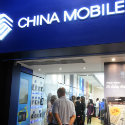
Ericsson and Nokia are said to have landed 5G-related core network contracts with China Mobile, the world's biggest mobile operator, despite fears that trade tension between the US and China could hurt their prospects.
Predictably enough, the lion's share of work reportedly went to Huawei, the homegrown equipment maker that has become a punching bag for US hardliners in recent months. Huawei secured 49% of MME/SGSN (Mobility Management Entity/Serving GPRS Support Node) and 54% of SAE-GW/GGSN (System Architecture Evolution Gateway/Gateway GPRS Support Node) equipment work, according to a report from the South China Morning Post that cites a document published on China Mobile's website.
Ericsson picked up 34% of the MME/SGSN work and another 34% on the SAE-GW/GGSN side, with Nokia landing shares of 12% and 9% in those respective areas. ZTE, a smaller Chinese vendor, won just 5% of the MME work and 3% of SAE orders.
While these are not the more lucrative contracts related to the deployment of 5G radio access networks, the deals with China Mobile are worth about $2 billion in total, according to a report from China Daily.
Nokia referred to the contracts as a "4G upgrade" in comments sent to Light Reading: "We're aware of the result of this 4G LTE network upgrade project, and we are delighted to play an important part in helping China Mobile realize its 5G ambitions with the upcoming commercial deployments," said a spokesperson by email. "China is an important market for Nokia -- we have been operating there for 40 years and have always been a trusted, strategic partner."
The deals are for 4G upgrades because the initial 5G radio access network (RAN) technology being deployed is based on the non-standalone (NSA) specifications included as part of the 3GPP's Release 15 documentation, whereby the new RAN interacts with the existing 4G evolved packet core (EPC). The specifications for the 5G core are still a work in progress as part of the 3GPP's Release 16 specifications, which are due to be released in the first half of 2020.
Light Reading was still awaiting a comment from Ericsson at the time of publication.
The deals would appear to show there has not been a knee-jerk response by China's government to the latest moves against Huawei. In the last few weeks, US authorities have added the Chinese vendor's name to a trade blacklist blocking commercial transactions with US companies including vital components and software suppliers. Senior US politicians have also continued to push for bans on Huawei in other countries, arguing its products may include "backdoors" for Chinese government spies.
Some experts had subsequently voiced concern that Chinese officials might respond by excluding Ericsson and Nokia from their own 5G market, although others pointed out this would restrict choice and drive up costs for Chinese operators.
The outcome may also give Ericsson bragging rights over Nokia as the two vendors battle for contracts in the 5G era. Any indication that Ericsson is winning a bigger share of core network deals with China Telecom and China Unicom, the other two big Chinese operators, would be a worry for Nokia, which has staked its reputation on its "end-to-end" capabilities and software expertise outside the radio access networks area.
Zero in on how network technology investment drives 5G services strategies. Join us for the free 5G Network & Service Strategies breakfast workshop in LA at MWCA on October 22. Register now to learn from and network with industry experts; communications service providers get in free!
However, it is too early to leap to any conclusions about the balance of 5G power between the two Nordic vendors based on these results. Chinese press reports indicate this is just a "first round" of 5G contracts, for one thing, so there is certainly further work to be awarded in the future, especially once the 3GPP's 5G core specifications are agreed and operators adopt standalone 5G RAN technology. Many operators, in China and elsewhere, are unlikely to sign major core network deals until those specifications are mature and the supporting telco cloud architectures are mature and deployed.
Important region
The Nordic vendors generated a similar share of their total revenues from business conducted in the China region during the first quarter of this year. Ericsson, which reported 48.9 billion Swedish kroner ($5.15 billion) in total revenues, said around SEK3.8 billion ($402.7 million) came from sales in North East Asia, while Nokia revealed that €434 million ($486.8 million) of its €5.03 billion ($5.64 billion) in revenues were generated in Greater China.
China Mobile's reported awards come shortly after Chinese authorities handed out 5G licenses a year earlier than originally planned. That move was seen partly as an attempt to bolster Huawei, which appears to be anticipating a decline in business performance because of US measures against it.
China may also be increasingly desperate to remain at the forefront of the 5G race as deployment activity gathers pace in the US market, where commercial services are already available in some communities.
The next-generation mobile technology may carry huge economic value if it gives rise to new types of service and provides a spur to industrial productivity.
Related posts:
— Iain Morris, International Editor, Light Reading
About the Author(s)
You May Also Like











